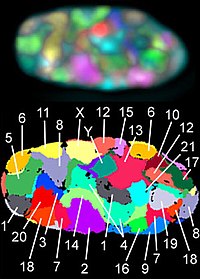In cell biology, chromosome territories are regions of the nucleus preferentially occupied by particular chromosomes.

Interphase chromosomes are long DNA strands that are extensively folded, and are often described as appearing like a bowl of spaghetti. The chromosome territory concept holds that despite this apparent disorder, chromosomes largely occupy defined regions of the nucleus.[1] Most eukaryotes are thought to have chromosome territories, although the budding yeast S. cerevisiae is an exception to this.[2]
Characteristics
editChromosome territories are spheroid with diameters on the order of one to few micrometers.[3]
Nuclear compartments devoid of DNA called interchromatin compartments have been reported to tunnel into chromosome territories to facilitate molecular diffusion into the otherwise tightly packed chromosome-occupied regions.[4][5]
History and experimental support
editThe concept of chromosome territories was proposed by Carl Rabl in 1885 based on studies of Salamandra maculata.[6]
Chromosome territories have gained recognition using fluorescence labeling techniques (fluorescence in situ hybridization).[7]
Studies of genomic proximity using techniques like chromosome conformation capture have supported the chromosome territory concept by showing that DNA-DNA contacts predominantly happen within particular chromosomes.
See also
edit- Transcription factories – Sites in the cell nucleus where DNA transcription occurs
- Nuclear bodies – Structures found in the cell nuclei
- Epigenetics – Study of DNA modifications that do not change its sequence
References
edit- ^ Meaburn, Misteli T (January 25, 2007). "Chromosome territories". Nature. 445 (7126): 379–781. doi:10.1038/445379a. PMID 17251970. S2CID 4426363.
- ^ Cremer T, Cremer M (March 2010). "Chromosome Territories". Cold Spring Harb Perspect Biol. 2 (3): a003889. doi:10.1101/cshperspect.a003889. PMC 2829961. PMID 20300217.
- ^ Meaburn, Misteli T (January 25, 2007). "Chromosome territories". Nature. 445 (7126): 379–781. doi:10.1038/445379a. PMID 17251970. S2CID 4426363.
- ^ Albiez, H; Cremer, M; Tiberi, C; Vecchio, L; Schermelleh, L; Dittrich, S; Küpper, K; Joffe, B; Thormeyer, T; von Hase, J; Yang, S; Rohr, K; Leonhardt, H; Solovei, I; Cremer, C; Fakan, S; Cremer, T (2006). "Chromatin domains and the interchromatin compartment form structurally defined and functionally interacting nuclear networks". Chromosome Research. 14 (7): 707–33. doi:10.1007/s10577-006-1086-x. PMID 17115328. S2CID 19283038.
- ^ Rouquette, J; Genoud, C; Vazquez-Nin, G. H.; Kraus, B; Cremer, T; Fakan, S (2009). "Revealing the high-resolution three-dimensional network of chromatin and interchromatin space: A novel electron-microscopic approach to reconstructing nuclear architecture". Chromosome Research. 17 (6): 801–10. doi:10.1007/s10577-009-9070-x. PMID 19731052. S2CID 32713660.
- ^ Cremer T, Cremer M (1 March 2010). "Chromosome Territories". Cold Spring Harb Perspect Biol. 2 (3): a003889. doi:10.1101/cshperspect.a003889. PMC 2829961. PMID 20300217.
- ^ "Chromosome Territories: The Arrangement of Chromosomes in the Nucleus". Nature Education. Retrieved 15 August 2015.